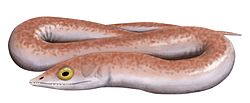You can help expand this article with text translated from the corresponding article in French. (January 2023)Click [show] for important translation instructions.
|
| Elpistostege Temporal range: | |
|---|---|
 | |
| Elpistostege watsoni on display at the Miguasha National Park | |
| Scientific classification | |
| Kingdom: | Animalia |
| Phylum: | Chordata |
| Clade: | Stegocephali |
| Family: | † Elpistostegidae |
| Genus: | † Elpistostege Westoll, 1938 |
| Species: | †E. watsoni |
| Binomial name | |
| †Elpistostege watsoni Westoll, 1938 | |
Elpistostege is an extinct genus of finned tetrapodomorphs that lived during the Frasnian age of the Late Devonian epoch. Its only known species, E. watsoni, was first described in 1938 by the British palaeontologist Thomas Stanley Westoll, based on a single partial skull roof discovered at the Escuminac Formation in Quebec, Canada. [1]
Contents
In 2010, a complete specimen was found in the same formation, which was described by Richard Cloutier and colleagues in 2020. It reveals that the paired fins of Elpistostege contained bones homologous to the phalanges (digit bones) of modern tetrapods; it is the most basal tetrapodomorph known to possess these bones. At the same time, the fins were covered in scales and lepidotrichia (fin rays), which indicates that the origin of phalanges preceded the loss of fin rays, rather than the other way around. [2] [3]







